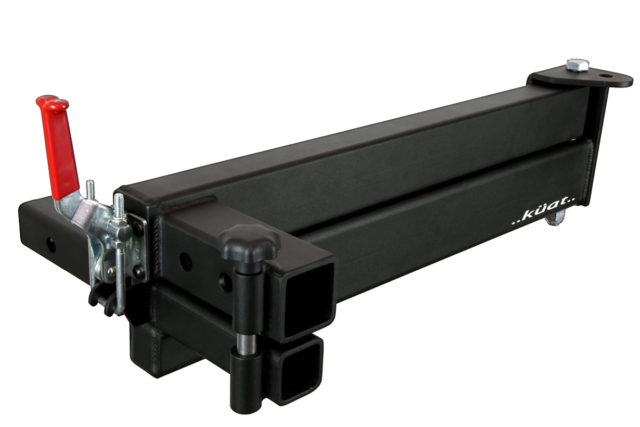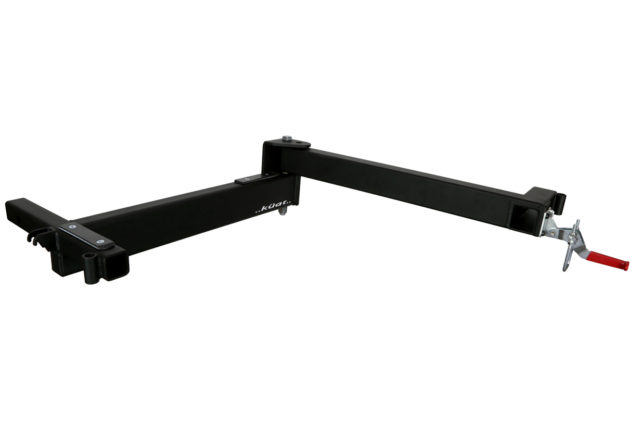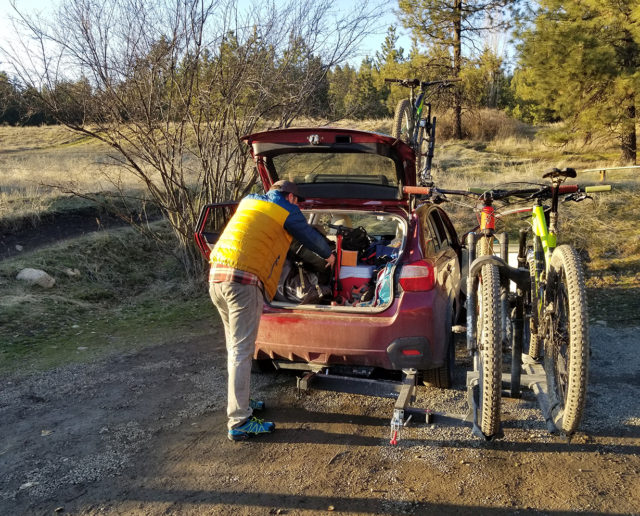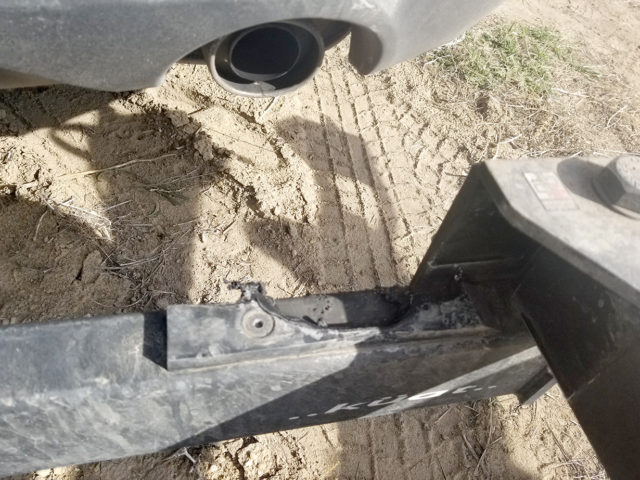
Kuat Pivot
Blister’s Measured Weight: 47.5 lbs (21.5 kg)
MSRP: $295
Test Location: The roads of Montana, Idaho, Washington, and Utah
Test Duration: ~4 months
Intro
A few companies have made swing-away style hitch racks in the past, but they were generally integrated with the rack. And just so we’re on the same vocabulary page, when I say swing-away hitch rack, I mean a rack that can be swung out to the side of the car to give full, unfettered access to the trunk / tailgate / hatch / whatever your vehicle has on its rear end. And while those integrated swing-away systems didn’t necessarily work poorly, they were heavy and expensive, especially if you already owned a hitch rack.
With the Pivot, Kuat has taken a stab at improving on that situation, and on the whole, I’d say they’ve come up with a fairly compelling offering.
Compatibility
The Kuat Pivot itself isn’t a bike rack — it has zero actual bike mounts on it. Its sole purpose is to swing some other (separately purchased) hitch-mounted bike rack away from the car. So if you already have a hitch-mounted bike rack that’ll fit a 2” receiver, you’re set — the bike rack should fit into the Pivot without a problem. While I’m sure Kuat would be happier if you used a Kuat rack, Kuat has confirmed that the Pivot will work fine with any rack that fits in a 2″ receiver.
It’s also noteworthy that the Pivot has a 250 lb load limit, which means you can use it with a fully loaded 4-bike rack. It does, however, mean that you probably can’t use something like a 6-bike Northshore rack on it. One other restriction that seems fairly self evident: you can’t tow anything with the Pivot.
Setup and Installation
The Pivot requires a nominal amount of setup before use — the latch needs to be attached, and the clamping force has to be dialed in. This is about 5 minutes of straightforward wrenching, and the tools are included.
Installation on the vehicle is pretty similar to installing a hitch rack; slide the Pivot on, line up the hitch pin hole, thread the hitch pin in, attach the lock. Done. Aside from being heavy (47.5 lbs) and somewhat awkward (like every hitch-mounted rack), there’s nothing much to say here.
Once the Pivot is attached to the car, you can attach your hitch rack to it. That process will essentially be identical to attaching the rack to your car, although the Pivot has two hitch pin holes, so you can choose whether you want the rack to sit closer or further from the car.
For future removal, there’s no problem taking the Pivot and attached rack off all at once, it’s just extra heavy — combined, the Pivot and rack can be around 100 lbs for some of the heavier racks.
Pivoting
Once everything is attached, using the Pivot is impressively quick and easy. You flip a red handle to open a latch, pull out a safety pin, give the bikes a shove and the whole deal swings (fairly effortlessly) out to the side.
The Pivot swings out a full 90° to the right, and with the extra offset of the rack, the bikes end up being well clear of the right side of the car. So even if you have a car with a trunk door that opens to the right, I’d speculate that the door would be able to fully open without the bikes getting in the way.

Swinging everything back into place to go back into “driving” mode is equally easy — shove the bikes to the left, drop in the safety pin, flip the latch, go. The only minor downside I can see here is that the safety pin isn’t tethered to the rack, so you have to manage to not lose it while the rack is open.
Stability, Clearance, and Dimensions
In terms of stability, the Pivot is pretty impressive. Once everything is snugged down, I’d rate the slop in the system as somewhere between “minimal” and “none.” There’s a nominal amount of additional flex in the system that comes purely by virtue of having more “stuff” back there, but it’s not particularly noticeable — the whole unit is quite stout. I had the Pivot paired with a Kuat NV 2.0 Base for most of my time with it, and the whole setup was solid. Going too fast on a not particularly smooth road, watching $10,000 worth of bikes in my rearview mirror didn’t yield any worrisome moments; they didn’t sway or wiggle appreciably more than they did without the Pivot attached.
The Pivot affects where the attached bike rack sits in relation to the car, but whether or not the change makes a difference (for better or worse) really depends on your specific car.
With the Pivot attached, the bikes sit about 2.75” higher, and between 9” and 11” further away from the rear of the car than they would if the rack were mounted directly to the car. While the height doesn’t make much difference for me, I’ve found that extra distance away from the car to be nice on a couple of vehicles because it took care of some handlebar / spare tire conflicts.

Some people that spend a lot of time on rough, rutted roads might get excited about getting the rack a bit higher for extra ground clearance. But while the rack itself is higher, the Pivot hangs relatively low. The actual pivot end of the Pivot, which sits behind the right rear tire, hangs about 4.5” below the center line of the hitch. Or in other words, it lowers the lowest point of your rack setup by a couple inches.
I had the Pivot mounted on a Subaru Crosstrek for a little while, and with that car fully loaded (and thus riding a bit lower in its suspension travel), I ended up scraping the low point on Pivot with a somewhat alarming frequency. On other, slightly higher vehicles, or even when the Crosstrek had less people in it, clearance with the Pivot wasn’t really an issue. But if you have a low car, that’s something to watch out for.
Downsides
I don’t have any overarching concerns with the Pivot — functionally it’s great, it’s constructed solidly, and it’s done what it’s supposed to do without much fuss. That said…
The one easy (and minor) thing I’d like to see is for the safety pin to be tethered to the rack — like I mentioned above, I could see an absent-minded cyclist misplacing it.
The other noteworthy things to watch out for are more vehicle specific. The first is the clearance issue I noted with the Crosstrek. Any low-ish car might run into problems (namely, the ground) due to the low point of the Pivot being a couple inches lower than the receiver hitch.
The second issue is that the Pivot only comes in a right-hand configuration. Meaning, the only option is to have the bikes swing away to the right. The problem, I’ve found, is on vehicles with rearward exhaust pipes on the right side — the exhaust hits the Pivot and gets it pretty toasty. This doesn’t create any issues for the bikes, but it did a number on one of the bushings that help the Pivot swing smoothly. However, this hasn’t affected the overall performance of the Pivot, and Kuat has indicated that future Pivots have actually been redesigned to remove that bushing, so newer versions of the Pivot likely won’t have any issues with exhaust pipe conflicts.

Aside from that exhaust-induced meltiness, the Pivot has been completely bomber. It’s spent much of its life on Montana roads in the early spring, which means plenty of mag-chloride and gravel getting spat at it. Thus far, it’s shrugged all of that off without issue; there’s no rust or degradation to note.
Bottom Line
I’ve driven around 5,000 miles with the Pivot attached to a few different vehicles, and it’s pretty tough to argue with the convenience. Even on cars where accessing the rear hatch is more or less do-able with a hitch rack attached, I still find myself using the Pivot — it’s just so quick and easy to get the bikes out of the way.
And while there are a couple issues noted above that are worth paying attention to, none of them are even close to being deal breakers for me. Particularly if I was driving any sort of modern SUV or crossover type vehicle, the Pivot seems like an ideal option.
At least for me, the Pivot is a bit like a dropper post. I survived without one for a long time. But now that I’ve used it, I’ll never go back. The Pivot just makes accessing the car so dang easy; I didn’t really realize how much I’d like it, but now that I’ve seen the light, it’s irrationally frustrating to use a rack that doesn’t swing out of the way.

Seems too small to work with a full size truck if you want to open the tailgate… limited functionality solution for a problem that kinda doesn’t really exist unless you are carrying 4 bikes which makes it difficult to lower the rack to open the trunk.
Hey Marcel,
It definitely works fine on full size trucks – it clears the tailgate on my F-350 no problem. Fully opened, the edge of the tailgate lines up with the hitch pin of the bike rack.
-Noah
I take that back then. Great to know it works on full size trucks!